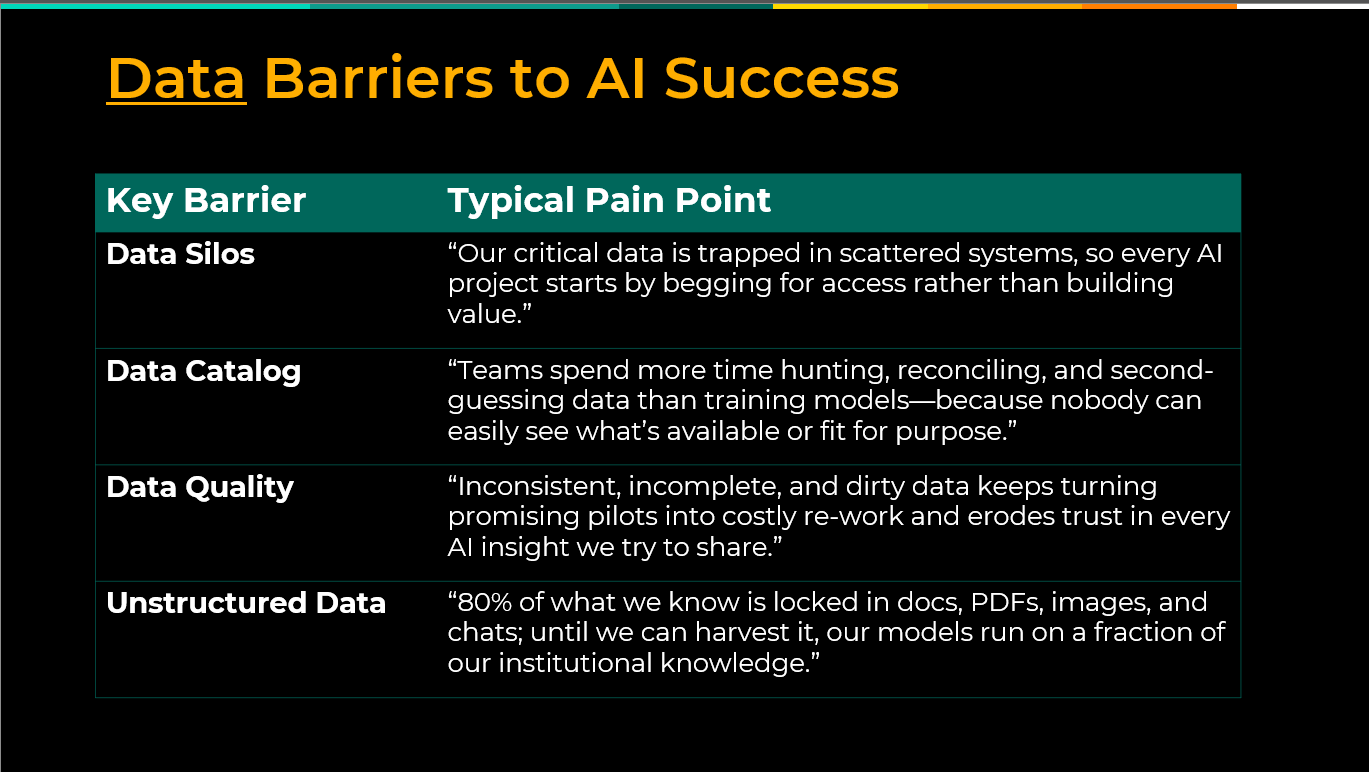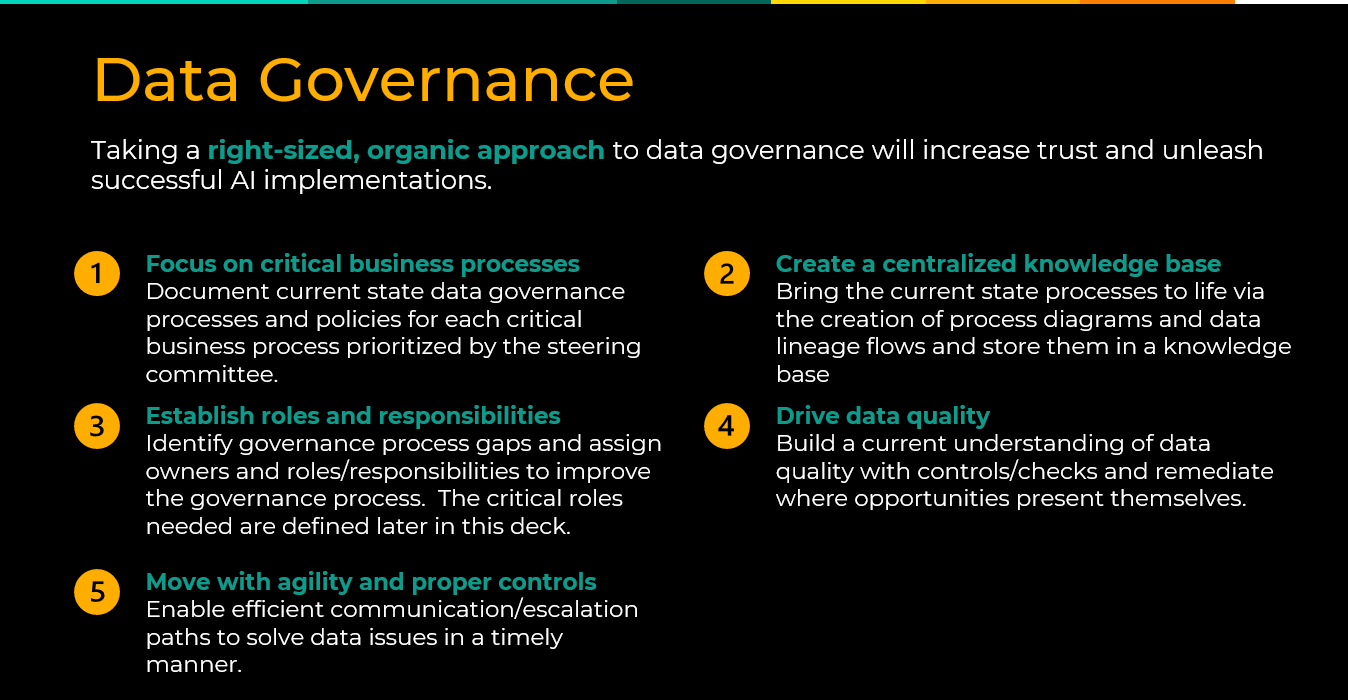AI Readiness Checklist for Data Leaders
Table of Contents
There’s no shortage of interest in AI across the enterprise. What’s less common is a clear understanding of what it takes to turn that interest into meaningful, scalable results.
Many organizations are still stuck in the early stages, delivering isolated proof of concepts that never quite make it to production. The technology might be sound, but the foundation beneath it often isn’t ready.
As a data leader, you’re in a critical position to close that gap. But without a clear view of where your organization stands or what steps to take next, it’s easy to lose momentum.
This checklist is designed to give you a structured way to assess AI readiness across five core areas: data foundations, governance, collaboration, prioritization, and scale. Whether you’re preparing for your first major use case or looking to accelerate what’s already underway, this is a practical starting point for moving forward with confidence.
Know Where You Stand

Before investing more time, resources, or tools into AI, it’s important to step back and assess where your organization is today. That doesn’t just mean identifying your latest POC, it means understanding how AI fits into your broader business and data strategy.
Different stages of AI maturity come with different needs. One organization may be experimenting with copilots inside individual teams. Another might be scaling predictive models into core workflows. Knowing the difference shapes what comes next.
Here’s what to check:
- We’ve identified our current stage in the AI adoption journey (exploration, pilot, production, scale).
- We’ve reviewed recent AI efforts and understand where momentum stalled or where it accelerated.
- Our leadership team sees AI readiness as a cross-functional effort, not just an IT initiative.
- We’ve aligned AI initiatives with business outcomes and can articulate the value we’re trying to create.
- Understanding where you are helps focus your investments and creates alignment across both business and technical teams.
Evaluate Your Data Foundations

Strong AI outcomes rely on strong data foundations. If your data is scattered, poorly documented, or hard to access, you’ll run into friction long before a model ever goes live.
Teams need to know what data exists, where to find it, and whether it can be trusted. Without that baseline, it becomes difficult to move from exploration to production with confidence.
A modern data catalog can be a force multiplier here, making data easier to discover, understand, and use across the organization.
Here’s what to check:
- We have a clear, documented view of where our most critical data lives.
- Data quality is being monitored, with known gaps or issues addressed early.
- A data catalog is in place or in progress to help teams discover and understand available assets.
- Unstructured data (documents, chat logs, transcripts) are being considered as part of our AI planning.
- The more accessible and reliable your data is, the easier it becomes to build AI solutions that scale.
Align on Definitions and Governance

AI breaks down when teams don’t have a shared understanding of the data. Inconsistent definitions, unclear ownership, and missing context create friction for analytics and every model built on top of that data.
Shared language and governance practices give teams the structure they need to collaborate, make decisions, and move forward with confidence.
A catalog can help reinforce this by providing a central location to store business definitions, manage data lineage, and track access controls, especially in distributed environments.
Here’s what to check:
- A business glossary exists for key terms and metrics used across teams.
- Data owners and stewards are clearly defined and actively engaged.
- Governance policies cover data lineage, sensitivity, and access controls.
- A process is in place to certify reports or datasets for enterprise use.
- Citizen developers understand which assets are trusted and where to find them.
- Governance creates alignment. It allows teams to move quickly while maintaining consistency and transparency.
Ready to assess your current state?
Lantern helps enterprise teams evaluate their data landscape, identify blockers, and take practical steps to improve AI readiness. From workshops to implementation support, we work with you to create a data environment that supports long-term AI value.
Prioritize Use Cases with Impact
Not every AI idea deserves to move forward. The most successful organizations focus on use cases that are clearly aligned to business goals, grounded in available data, and supported by engaged stakeholders.
Evaluating the feasibility of a use case means looking at more than just its potential value. Consider whether the required data exists, whether the team has the skills to support it, and whether the business is ready to adopt the outcome.
Here’s what to check:
- We’ve identified a short list of AI use cases tied to specific business outcomes.
- Data availability and quality have been evaluated for each use case.
- We’ve involved business owners early to validate relevance and feasibility.
- We’ve prioritized use cases that can show results in a reasonable time frame.
- Teams understand what “done” looks like and how success will be measured.
- Clear prioritization builds credibility. It keeps efforts aligned with the business and helps unlock the support needed to scale.
Plan for Scale, Not Just Pilots
A successful proof of concept is a milestone, not the finish line. Real value comes when AI moves beyond a controlled environment and starts delivering results across teams, processes, and systems.
Scaling takes more than a working model. It requires infrastructure, support, and a plan for how the solution will be maintained over time.
That includes automation pipelines, retraining processes, and clarity around who owns both the technical implementation and the business outcome.
Here’s what to check:
- Success criteria are defined beyond the pilot stage.
- A plan exists for deploying the solution into production.
- Stakeholders are aligned on how the model will be maintained, retrained, and monitored.
- Ownership is clearly defined for both technical implementation and business impact.
- Lessons from early efforts are feeding into future roadmap planning.
- Sustained impact comes from building operational support around what works and treating scale as a strategic goal, not an afterthought.
Conclusion
AI readiness doesn’t happen by accident. It takes clarity around your current state, a solid data foundation, shared definitions, and a clear path from pilot to scale.
This checklist is a starting point. It’s meant to help data leaders ask the right questions, uncover gaps, and bring the right people into the conversation early. Most importantly, it helps shift the focus from experimentation to execution.
If your organization is serious about moving AI forward, these fundamentals need to be in place. Start where you are, prioritize what matters, and build from there.
Want to go deeper?
Watch our AI Momentum webinar for practical strategies on building a data foundation for AI at scale.
